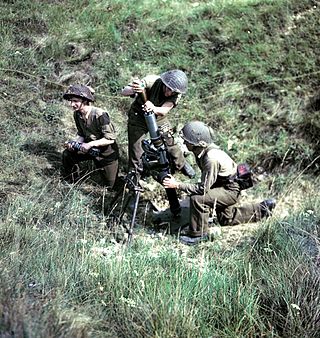ML 3-inch mortar
United Kingdom's standard mortar from the early 1930s to the late 1960s From Wikipedia, the free encyclopedia
The Ordnance ML 3-inch mortar was the United Kingdom's standard mortar used by the British Army from the early 1930s to the late 1960s, superseding the Stokes mortar. Initially handicapped by its short range compared to similar Second World War mortars, improvements of the propellant charges enabled it to be used with great satisfaction by various armies of the British Empire and of the Commonwealth.
| Ordnance ML 3-inch mortar | |
|---|---|
 Canadian 3-inch mortar team | |
| Type | Mortar |
| Place of origin | United Kingdom |
| Service history | |
| Used by | See Users |
| Wars | Second World War Indo-Pakistani War of 1947–1948[1] 1948 Arab–Israeli War Korean War Suez Crisis[2] Sino-Indian War[3] Nigerian Civil War Soviet-Afghan War |
| Production history | |
| Designed | 1930s |
| Specifications | |
| Mass |
|
| Length | 4 ft 3 in (1.3 m) |
| Barrel length | 3 ft 11 in (1.19 m)[4] |
| Shell | Bomb 10 lb (4.5 kg) |
| Calibre | 3.19 in (81.0 mm) |
| Elevation | +45° to +80° |
| Traverse | 11°[4] |
| Muzzle velocity | 650 ft/s (200 m/s) |
| Maximum firing range | Mk.II: 1,600 yd (1,500 m) Mk.II LR: 2,800 yd (2,600 m) |
Design
The ML 3-inch mortar is a conventional Stokes-type mortar that is muzzle-loaded and drop-fired. It also reuses many of the Brandt mortar features.[5]
History

Based on their experience in the First World War, the British infantry sought some sort of artillery for close support. The initial plan was for special batteries of artillery, but the cost was prohibitive and the mortar was accepted instead.

The Mark II mortar (Mark I was the Stokes) was adopted by the British Army in the early 1930s; and this was the standard British mortar when the Second World War broke out in September 1939. Experience in the early part of the war showed that, although the Mark II was reliable and sturdy, it did not have sufficient range compared to the German 81 mm s.GW.34 mortar. A series of experiments and trials using new propellants improved the range from 1600 yards to 2800 yards by about 1942; and, by 1943, the barrel, baseplate and sights had also been improved.[5][6]
The ML 3-inch mortar was carried on three packs by infantry or on Universal Carriers.[6]
The Mark II remained in service with the British Army until replaced by the L16 81mm mortar in 1965.
Variants
- Mark 4 - heavier baseplate and new sight
- Mark 5 - lightened for use by airborne units and in the Far East
- The Canadian Army modified some of its 3-inch mortars, lengthening them to increase their range. This modification was abandoned as it was considered too heavy.
- The Australian Army, for its part, shortened the barrel for use in jungle.[6]
Users


 Afghanistan: used by the anti-Soviet insurgents in the 1980s[7]
Afghanistan: used by the anti-Soviet insurgents in the 1980s[7] Australia[8]
Australia[8] Biafra[9]
Biafra[9] Canada[8]
Canada[8] Egypt[10]
Egypt[10] Greece
Greece India[3]
India[3] Iraq[11]
Iraq[11] Ireland[citation needed]
Ireland[citation needed] Italy (1944–1946)[citation needed]
Italy (1944–1946)[citation needed] Jordan[12]
Jordan[12] Luxembourg[citation needed]
Luxembourg[citation needed] Myanmar
Myanmar
- Myanmar Army : Inherited from British-Burma Army and also bought from India.Main Medium mortar used till 1970s.[13]
 New Zealand[8]
New Zealand[8] Nigeria[14]
Nigeria[14] Pakistan[1]
Pakistan[1] Philippines[citation needed]
Philippines[citation needed] Poland: Polish Armed Forces in the West[15]
Poland: Polish Armed Forces in the West[15] South Yemen[16]
South Yemen[16] Tibet[citation needed]
Tibet[citation needed] United Kingdom[8]
United Kingdom[8] Yugoslavia: Used by Yugoslavian Partisans[17]
Yugoslavia: Used by Yugoslavian Partisans[17]
See also
- Stokes mortar : British WWI predecessor
- List of infantry mortars
Weapons of comparable role, performance and era
- 8 cm Granatwerfer 34 – German WWII equivalent
- 82-BM-37 & 82-PM-41 – Soviet WWII equivalents
- Brandt Mle 27/31 – French WWII equivalent
- M1 mortar – US WWII equivalent
- Type 97 81 mm infantry mortar – Japanese WWII equivalent
Gallery
References
Wikiwand - on
Seamless Wikipedia browsing. On steroids.





